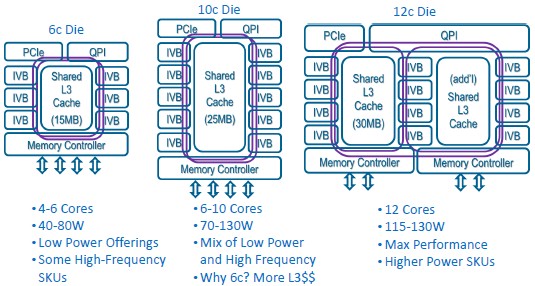An evolving marketplace causes Intel to flip the order in which new CPU technologies are introduced.
By Alex Herrera
[Editor’s Note: This is first in a two-part series on next-generation CPUs from Intel. This article introduces the CPU’s; tomorrow’s article introduces the first workstations and servers to include Ivy Bridge-EP. A link to the second article will appear at the end of this article after it becomes available online.]
At Intel Developers Forum (IDF) this year, Intel formally launched the highly anticipated Ivy Bridge generation successor for high-performance, dual-socket capable servers and workstations.
The appearance of Ivy Bridge-EP around now was no surprise at all, as the pattern of SKU and brand launches for each generation has been relatively consistent. First, Intel rolls out the more highly integrated processors (i.e. with integrated GPU, or what Intel calls Processor Graphics) which primarily target single-socket desktops and mobiles. Then some time later—the time lag has been stretching as of late—the company releases SKUs targeting higher-performance, dual-socket capable servers and workstations. In the middle are EP (Efficient Processing) devices and the more highly scalable server and HPC devices.
Dual-socket Ivy Bridge-EP shows up after Haswell
Oddly enough, and for the first time, Intel released the -EP version of one generation microarchitecture after it had already released initial SKUs of the succeeding generation. After all, Haswell is already out in the market driving consumer and corporate PC class machines, and low-end workstations, like HP’s Z230.
Now, at first glance, the delay to Ivy Bridge and overlap with Haswell might seem like a huge mistake. After all, wouldn’t that be very awkward—and potentially cannibalizing—for a low-end Haswell-based machine to out-perform a high-end Sandy Bridge-EP or Ivy Bridge-EP system based on a platform one or two generations older?
Not today, because of the way the microprocessor design has evolved. Today, a next-generation core doesn’t necessarily perform a whole lot better than the previous generation on single-thread workloads (like 10%-ish better). The early releases of a new generation tend to have fewer CPU cores to make room for ever-larger integrated GPUs. Conversely, later releases (for servers, workstations and high-performance PCs) tend to drop the GPU for more CPU cores. Workstations tend to not leverage an integrated GPU (very much) making those early SKUs less interesting for the upper end of the workstation product line. And conversely, the later releases are more appealing for the performance sector, since they deliver a lot more CPU cores to pair with a high-performance discrete workstation GPU.
Ivy Bridge is primarily a shrink of Sandy Bridge to 22 nm. In Intel’s parlance, it’s a tick to the Sandy Bridge Tock. Ivy Bridge’s CPU got some modest improvements. And its GPU actually received some substantial boosts, as Intel continues to try to get its graphics more on par with rival AMD. Mostly, the point of a tick is to dial up performance to implement more of the same resources … most notably by adding a whole bunch more CPU cores.
How many more cores? Well, that depends on which of the trio of Ivy Bridge-EP incarnations we’re talking about. Intel created three in 22nm technology: 6-core (6c), 10-core (10c), and 12-core (12c). The 6c is designed for high-density server applications where minimal power dissipation is critical (low power offerings available). On the other end of the spectrum, the 12c will appeal to high-performance server applications, with maximum core count and additional 5 MB of L3 available. So, though it might appear as ironic, counter-intuitive, or even a huge screw-up to release previous generation processors after the “much improved” new generation appears, upon closer inspection it’s a rollout that makes perfect sense for Intel.

In the middle is the sweet spot for workstations, with the 10c making both 10-core and 8-core SKUs available. The 8-core will likely be the hottest seller for workstations, offering a nice blend of core count with the highest clock frequencies available.
|
Xeon E5 numbering |
# of cores / |
clock speed |
Cache |
TurboBoost |
HyperThreading |
| E5-2697 v2 |
12/24 |
2.7 GHz |
30 MB |
2.0 |
yes |
| E5-2695 v2 |
12/24 |
2.4 GHz |
30 MB |
2.0 |
yes |
| E5-2690 v2 |
10/20 |
3.0 GHz |
25 MB |
2.0 |
yes |
| E5-2687W v2 |
8/16 |
3.4 GHz |
25 MB |
2.0 |
yes |
| E5-2670 v2 |
10/20 |
2.5 GHz |
25 MB |
2.0 |
yes |
| E5-2667 v2 |
8/16 |
2.7 GHz |
30 MB |
2.0 |
yes |
| E5-2660 v2 |
10/20 |
2.2 GHz |
25 MB |
2.0 |
yes |
| E5-2650 v2 |
8/16 |
2.6 GHz |
20 MB |
2.0 |
yes |
Specs for 8, 10, and 12 core-count Ivy Bridge-EP SKUs most appealing for workstation applications (4-core and 6-core also available). (Source: Intel)
[Editor’s Note: For the second article in this series, see, “Intel launches next generation Ivy Bridge-EP CPU family.”]






